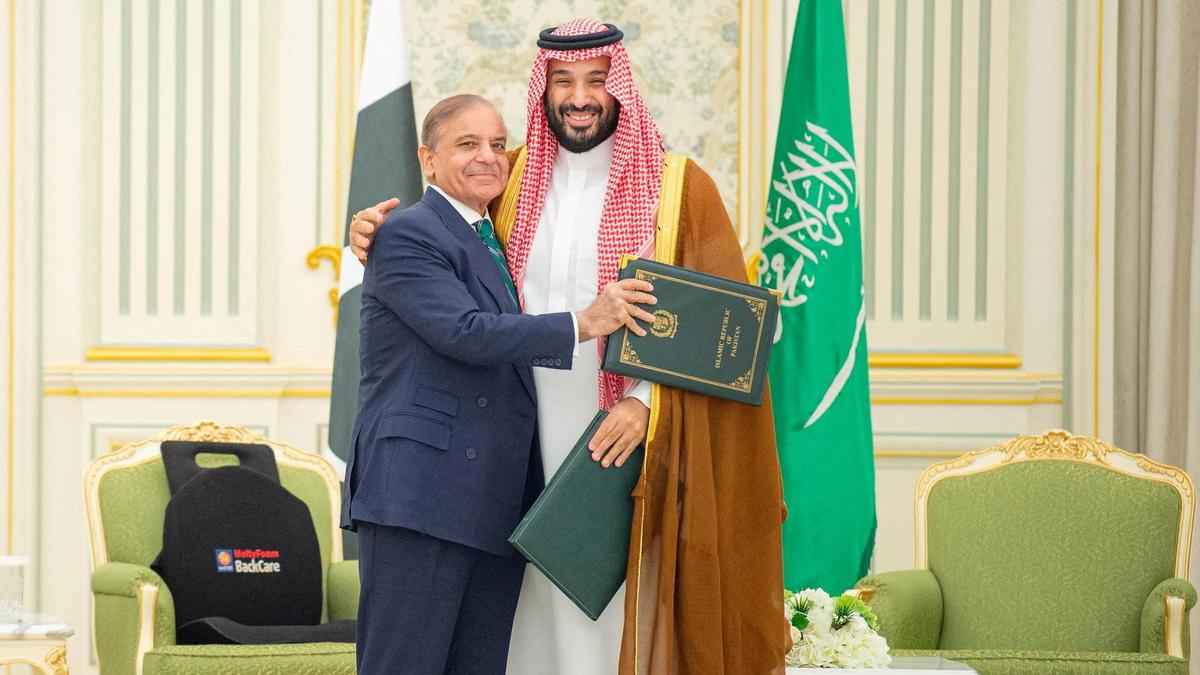Saudi–Pakistan Strategic Mutual Defence Agreement (SMDA)

- 23 Sep 2025
In News:
- Recently, Saudi Arabia and Pakistan signed a Strategic Mutual Defence Agreement (SMDA) in Riyadh, formalising a long-discussed framework for joint defence and mutual security.
- The agreement, viewed as a landmark in bilateral ties, symbolises a renewed effort to institutionalise their security partnership amid changing regional dynamics and waning U.S. influence in West Asia.
Nature and Scope of the Pact
- The SMDA commits both nations to collective defence, stipulating that any attack on one country will be treated as an attack on both.
- It builds upon the 1982 Bilateral Security Cooperation Agreement, strengthening channels of military coordination, intelligence exchange, training, and arms trade.
- The pact extends across conventional defence cooperation, advisory roles, and — in principle — joint deterrence, though not explicitly nuclear.
Strategic Context
- The timing of the agreement follows rising regional uncertainty, including Israel–Qatar tensions, Yemen conflict spillovers, and Iran–Saudi rivalry.
- By signing the SMDA, Riyadh signals its intent to pursue greater regional self-reliance in defence, moving beyond full dependence on the U.S. security umbrella.
- For Pakistan, it secures much-needed economic and energy support from Saudi Arabia amid a deep fiscal crisis, while reaffirming its role as a key security partner in the Islamic world.
Key Drivers
- Mutual Security Assurance: Establishes a framework for joint deterrence and defence coordination.
- Economic Complementarity: Opens avenues for Saudi financial assistance, arms procurement, and energy trade with Pakistan.
- Symbolic Islamic Solidarity: Positions Pakistan as a pan-Islamic security contributor, enhancing its strategic visibility.
- Regional Rebalancing: Demonstrates Saudi Arabia’s effort to diversify security partnerships beyond Washington and regional blocs.
Implications
1. For India
- Strategic Caution: While the pact theoretically enables Pakistan to seek Saudi backing in a potential India–Pakistan confrontation, Riyadh’s growing ties with India — including $42.9 billion in bilateral trade, defence collaboration, and major investments — make an overt anti-India stance unlikely.
- Diplomatic Opportunity: New Delhi can leverage its energy and economic partnerships to maintain Saudi neutrality in South Asian affairs.
- Policy Imperative: India must sustain strategic dialogue and ensure Arab neutrality in regional crises through proactive diplomacy.
2. Regional and Global Dimension
- Shift in Gulf Security Architecture: Reflects a decline in U.S. dominance and emergence of a multipolar Gulf order, with Riyadh exploring independent alliances.
- Iran–Saudi–Pakistan Equation: Enhances Saudi deterrence posture against Iran, Yemeni Houthis, and potentially Israel’s unilateral actions.
- Nuclear Sensitivities: Raises concerns about possible nuclear collaboration, though the actual transfer of Pakistani nuclear technology to Saudi Arabia remains highly improbable, constrained by global non-proliferation norms and Israeli sensitivities.
Way Forward for India
- Deepen Defence and Security Cooperation: Expand joint training, exercises, and intelligence exchanges with Saudi Arabia.
- Energy Diplomacy: Pursue long-term crude oil and green hydrogen partnerships to consolidate interdependence.
- Strategic Monitoring: Closely track SMDA implementation, including possible Pakistani troop deployments or defence projects.
- Maritime Synergy: Strengthen India’s presence in the Arabian Sea through naval cooperation to protect vital energy routes.
- Economic Leverage: Utilize India’s market potential and diaspora network as stabilising anchors in Indo-Saudi relations.
